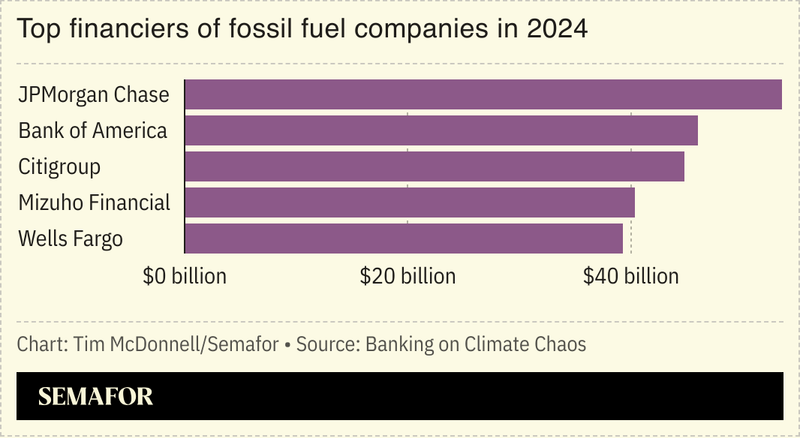The News
The world’s 65 biggest banks, led by JPMorgan and Bank of America, increased their commitment to fossil fuels in 2024 compared with the previous year, reversing what had been a declining trend and illustrating just how reluctant Wall Street is to give up on what remains a major profit center.
About half of the total lending and underwriting of $869 billion went to companies that are not just maintaining existing fossil fuel production and distribution infrastructure but investing in new assets, according to a new report by a coalition of environmental groups: The International Energy Agency has warned that activity is incompatible with the Paris Agreement global warming goals.
Of the top five fossil fuel financiers, four are US-based, and all five withdrew in the past year or so from a net-zero banking coalition.

The data, Lucie Pinson, executive director of the French advocacy group Reclaim Finance, argues, shows that banks are unwilling to act sufficiently on climate on their own, and need more regulation to align their activities with the long-term decarbonization commitments that European countries, at least, still have. But in the current political climate, she said, that kind of regulation is unlikely to materialize: “Banks think the reputational risk for not acting on climate is also decreasing.”
In this article:
Tim’s view
The new financing data looks like a letdown for climate activists, who would love to see Wall Street close off the “money pipeline” that keeps oil and gas flowing. But there are a few silver linings in the data that point to vulnerabilities, not strengths, for Big Oil.
An important driver of the jump in financing last year was a step down in many central banks’ interest rates, which made it more attractive for fossil fuel companies to borrow money. Low interest rates also tend to make a stronger market for bonds, which would lead to an increase in banks’ underwriting for all companies, including fossil fuels. But lower interest rates also help capital-intensive renewable energy projects — so higher lending to fossil fuels points to more favorable conditions for their clean competitors. And if more oil companies are knocking on banks’ doors for those loans, it’s a sign that they’re less able to draw on their own cash flow.
The report also found that about 12% of the financing increase is attributable to money earmarked for supporting mergers and acquisitions. Last year saw an unusual number of huge M&A deals among oil companies, including ExxonMobil’s $60 billion purchase of Pioneer Natural Resources and Diamondback Energy’s $26 billion merger with Endeavor Energy Resources. Those deals are a sign that business is becoming more difficult for smaller oil companies; in a world where oil demand plateaus and the price falls, bigger companies with more operational efficiency will be the only ones that can still turn a reasonable profit. An increase in M&A financing, in other words, is actually a sign that the energy transition is proceeding in the direction climate activists would like to see.
The report data isn’t granular enough to see how all of the financing is being put to use — most of it is corporate-level, not project-level, finance. But it’s likely that some of the boost is due to the renewed global push to build out natural gas export hubs and other gas infrastructure to feed the surging global demand for electricity. And often, the gas buildout serves to reduce consumption of coal, which is dirtier.
The View From JPMorgan
A spokesperson for JPMorgan said the bank is “one of the world’s largest financiers to both traditional and clean energy companies,” and that a better way to understand its energy finance activities is to look at the ratio between the two, which currently stands at about $1.29 for clean energy for every $1 supporting fossil fuels. A Citi spokesperson also said the bank “supports the transition to a low-carbon economy” and is working toward a goal to invest $1 trillion in sustainable enterprises. Spokespeople for the other top fossil fuel banks declined to comment.
Notable
- Sales of green bonds in the US have fallen since Donald Trump resumed office. Companies are increasingly reluctant to call attention to, or fundraise off of, their sustainability initiatives, the Financial Times reported, so the volume of green bonds issued in the US so far this year is down to $24.4 billion compared to $43.3 billion at the same time last year.


